Music City’s New Symphony Hall Organ
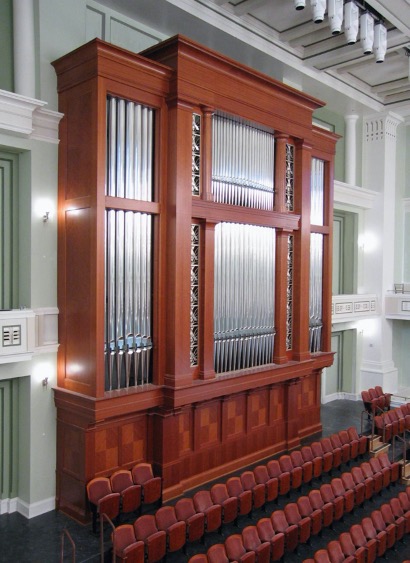
In its February 1982 issue, The Diapason published an article that challenged conventional wisdom. (See reprint of the article on pages 27–28 of this issue.) In it, Calvin Hampton made a convincing argument that an organ designed to be an instrument of the symphony orchestra must be radically different in many respects from a church organ or even a concert organ intended for solo use. A “normal” organ, even a fine one, could not pass his audition for symphony hall use. This really caught my attention. Since my background had included playing in and managing symphony orchestras, I was keenly aware of the uneasy relationship between orchestras and pipe organs. To managements, the organ was a headache. It used up too much space and too much money. Stagehands didn’t like the extra hassle of set-ups and working out quiet time for maintenance. Musicians didn’t like tuning to the organ or listening to its quinty mixtures and other thin, shrill sounds. Conductors never seemed satisfied with either the tone color or volume produced. Comments heard over and over again were: “I like that tone, can it be louder?” “Good balance, but I’d like a fuller, darker tone.” “Please(!)—keep with my beat!” The organist’s answers usually provoked frustrated and sometimes colorful comments about the inflexibility of the organ. The poor organist had even more problems than these: scarce rehearsal time, balance problems if the console was attached to the organ, poor sightlines if the console was on stage but too large or placed off in a corner.
The biggest problem of all was disappointment for the audience. The power of a modern symphony orchestra is so immense that most concert hall organs could not add to the drama of a fortissimo tutti. Against the gravity of the full orchestra, an ordinary organ can sound pathetically thin and upside down in balance, with trebles screaming out over the top of the ensemble. I had wondered for a long time why no one had attempted to solve all of these problems with an innovative approach. Calvin Hampton’s article gave me hope that someone would. About ten years later the tide began to turn. The musical issues were being addressed and many of them quite successfully. However, as a former instrumentalist and symphony manager, I thought that a more radical approach was needed.
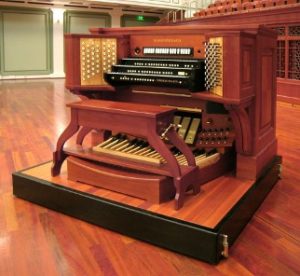
Solving problems
Most of the behind-the-footlights practical problems can be solved by adopting an obvious, but, in some quarters, unpopular guideline: employ the fewest stops necessary to get the musical job done. This means an instrument that takes up less space, is less costly to purchase and more efficient to maintain. The case or chamber can be shallow for best tonal egress. Layout can be arranged for temperature—and thus tuning—stability; for example, all chorus work on one level, all reeds on one level. The console can be more compact, promoting sightlines and ease in setting and striking. The concept is easy enough to adopt, but what is that magic number of stops? What is the musical job to be done? How can we produce adequate power that will satisfy the audience?
First, it should be established that we are considering an instrument primarily for the Romantic and Modern repertoire. A properly equipped symphony hall should have one or two mechanical action stage organs to take care of the earlier repertoire. Previous experiments to include a “baroque” division with a small console as part of a large instrument have not been successful.
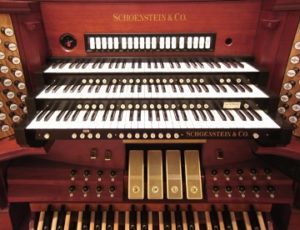
The primary use of the organ will be with orchestra. As a solo instrument, it might be used on occasion for choral accompaniment, silent movies as part of a pops series, and some special events. The solo organ recital has turned out to be a rarity in symphony halls. This is also true of other instrumental or vocal recitals. The reasons are simple: economics and scheduling.
If this musical job description is accurate, then an instrument in the size range proposed by Calvin Hampton (46 voices) would be ideal. Certainly any well-designed instrument of that size should also be able to render a very convincing recital program when needed. The key to a great performance is great tone, not great size.
If client and builder have the discipline to follow this Multum in Parvo plan rigorously, the question of tonal design becomes a matter of selecting stops that are absolutely essential and living without those that would be nice to have. Several classes of stops can be excluded with ease because they are duplicated in the symphony orchestra. Certainly there is no need for multiple strings and celestes or for orchestral reeds such as French Horn, English Horn, and Orchestral Oboe. The organ does not need items that would be considered necessities in a comprehensive church organ or in one specialized for some branch of the organ solo repertoire or for transcriptions.
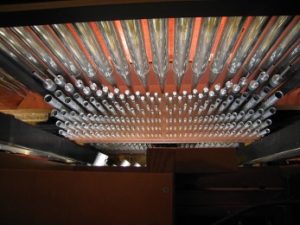
What, then, are the elements that a symphony hall organ must have? Understanding what musical value the organ can add to the orchestra leads us to the answer. There are three characteristics of the organ that differentiate it very clearly from the orchestra. First, its frequency range is far greater. It can extend octaves below and above the orchestra. Extending the bass range has been the feature most appreciated by composers and orchestrators; however, increasing the treble range can be attractive, provided that it doesn’t get too loud! The second special characteristic of the organ is its unique tone—the diapason. This is a tone that cannot be produced by the orchestra and should, therefore, be the backbone of the organ when heard with the orchestra. The third element that should be most intriguing to composers is the organ’s ability to sustain indefinitely. This feature is most artistically displayed in connection with good expression boxes. A long, continuous diminuendo or crescendo can be most effective.

Four vital design points
Since there is a general understanding of basic organ tonal elements common to composers who write for orchestra as well as for the organ, a good symphony hall organ must include the minimum architecture of a normal three-manual traditional Romantic organ: diapason choruses and chorus reeds on each manual, representatives of stopped, open and harmonic flutes, a string with celeste, flute mutations, and the most common color reeds (Oboe, Clarinet, and Vox Humana). To make the organ capable of working in partnership with a modern symphony orchestra, the following tonal elements must be incorporated into this traditional scheme:
1. Profound Pedal. This is the most important element an organ can add to a symphony orchestra—bass one or two octaves below the double basses, bass tuba and contra bassoon. There must be at least one stop of such immense power that it will literally shake the floor. Stops of varying colors and dynamics with some under expressive control complete the Pedal.
2. Solo stops unique to the organ. These may be tones not found in the orchestra such as a diapason, stopped flute, and cornet or imitative stops that can be voiced at a power level not possible from their orchestral counterparts, such as solo harmonic flutes, strings, clarinets, and high pressure trumpets and trombas.
3. One soft stop capable of fading away to a whisper. Perhaps best in this role is a strongly tapered hybrid (or muted) stop.
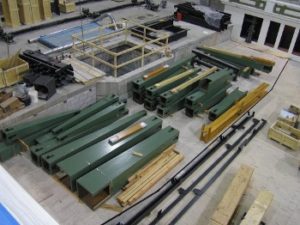
4. An ensemble of exceptionally high power under expression. This cannot be raw power. It must be power with beauty, centered in the 8′ and 4′ range to give a sense of solidity and grandeur. Since symphony halls are generally drier acoustically than the typical organ and choral environment, it is even more important that this power be concentrated in the mid-frequency range and be of warm tonal character. The false sense of power created by excessive emphasis in high-pitched tones should be avoided. Orchestras don’t rely on a battery of piccolos for power, why should the organ? Piccolos can dominate an orchestra and so can mixtures, but that doesn’t make either effect beautiful. The kind of power needed comes from moderate to high wind pressures and stops voiced with rich harmonic content for good projection. Upperwork should be for tonal color rather than power. At least one diapason chorus should include a very high pitched mixture, a tone color unique to the organ, but it must not be loud. Eight-foot diapasons, chorus reeds, open flutes and strings should work together to create an ensemble capable of standing up to a full symphony orchestra. As someone who has sat in the midst of a symphonic brass section, I have a clear idea of the kind of power that is generated by trumpets, trombones and horns at fff. To compete without sounding shrill and forced requires high pressure diapasons and reeds, including a 32′ stop—all under expression to fit any situation.
Good tonal design must be supported by a mechanism that helps the organist solve all the performance problems mentioned above—an instrument that is as easy as possible to manage. The organ builder should employ every device at his command to give the organ musical flexibility so that it can take its place as an equal among the other instruments of the orchestra.
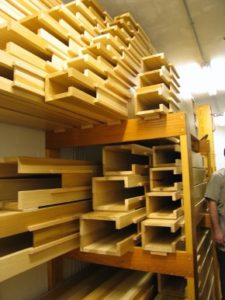
The Nashville project
We were given an opportunity to demonstrate the effectiveness of these ideas in our project for the Schermerhorn Symphony Center in Nashville. This was one of those projects that went smoothly from beginning to end, with everything falling into place and no road blocks in the way. Of the greatest importance to the success of this job was the client’s clear musical goal and realization that a really great organ can’t be all things to all people. We had a well-defined mission: to build an instrument that is a member of the orchestra. To this end we worked from the beginning with Andrew Risinger, organ curator and symphony organist and also organist/associate director of music at West End United Methodist Church in Nashville.
We were appointed, at the very beginning of the project, to the design team that included acoustician Paul Scarbrough of Akustiks in Norwalk, Connecticut and design architects David
M. Schwarz, Architectural Services of Washington, D.C. I had worked with both as organ consultant for the Cleveland Orchestra in the renovation of Severance Hall and its E. M. Skinner organ. The design team, under the skillful management of Mercedes Jones, produced a hall that could not be more perfect from our point of view. Seating 1,872, it is beautiful in its traditional design, excellent proportions, and fine materials. It is of the traditional “shoebox” shape that everyone knows is perfect but that few architects are willing to employ. Since, under the direction of Paul Scarbrough, all of the traditional acoustical rules were followed, the result is, indeed, perfect.
Reverberation time is controlled by dampening material that may be added or subtracted at will. There is excellent balance, clarity, and pleasing resonance even in the lowest reverberation setting. With all dampening material lifted out of the way at the press of a button, the hall is ideal for most organ and choral repertoire. In addition, there is one very unusual and practical feature that has an added impact for the organ. The orchestra seating section can be converted to a flat open floor for pops concerts and special events. Most of the transformation is accomplished automatically through a labyrinth of gigantic machinery in the basement. The huge expanse of polished wood flooring adds significant reverberation. This feature also, interestingly enough, increases the usage of the organ. The hall is often rented for weddings. This is perhaps the only
symphony hall organ in the world that has a reason to play the Mendelssohn and Wagner marches!
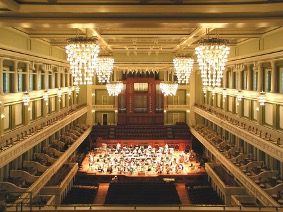
The organ is in an ideal position just above the choral risers at the rear of the stage. The casework was designed in close cooperation with the architectural team and Paul Fetzer whose company, Fetzer Architectural Woodwork of Salt Lake City, built the façade along with the other woodwork of the hall. It affords full tonal egress from the open front chamber behind it, which is shallow for accurate unforced projection. The organ is arrayed on three levels. Most flues are on the first level. Reeds, celestes, some flutes and offsets are on the second, and Pedal on the third, with the exception of the Trombone and Diaphone, which occupy a space extending all three levels. The bass octave of the 32′ Sub Bass is in a most unusual spot—located horizontally underneath the patron’s boxes to the left and right of the stage apron! These large scale pipes produce a soft 32′ tone that is felt as well as heard throughout the entire auditorium. The 32′ Trombone is in its own expression box, and the Swell includes our double-expression system, wherein the softest and most powerful voices are in a separate enclosure at the rear of the Swell with shades speaking into the Swell. The Vox Humana is in its own expression box inside the double expressive division of the Swell and so is, in effect, under triple expression. Accurate climate control has been provided, keeping the organ at constant humidity and temperature. The blower room in the basement has its own cooling system to neutralize the effects of blower heat build-up. Intake air is filtered.
The instrument employs our expansion cell windchests and electric-pneumatic action. This allows uniform, fast and silent action for all pipes no matter their pressure as well as easy console mobility and the borrowing of stops for maximum flexibility. Obviously borrowing is employed heavily in the Pedal, but it is also used on the Great, where the high pressure diapasons 8′ and 4′, string, stopped flute, Cornet and Solo reeds are all available independently. It also makes practical the extension of Pedal stops into the Solo and facilitates an interesting effect, the Tuben stop, which borrows the Swell reeds onto the Solo at unison pitch (Posaune up an octave at 8′ and Clarion down an octave at 8′ along with the 8′ Trumpet).
The console has the usual playing aids, but has been kept as simple and straightforward as possible to facilitate efficient rehearsals. There is a record-playback system—helpful for rehearsals and also for house tours; the playback mechanism can be remotely controlled by tour guides. With the press of a button they can start the blower and select a demonstration piece to be played for public tours, which are a popular attraction in Music City.
Tonal design
The two pillars of tone are diapasons and trumpets. The manual diapason choruses contrast in tonal color and power. The Swell chorus (Manual III) is based on a slotted 8′ Diapason of
moderate power with a slightly tapered 4′ Principal and a 2′ Mixture, which is under double expression. The Great (Manual II) has a large scale 8′ Diapason with upperwork through 1⁄3′ Mixture and a slotted, smaller scale double. The Solo (Manual I) has the largest scale and most powerful chorus, all under expression and at 10″ pressure. Its mixture can be drawn with and without a tierce. The trumpets range from closed, tapered shallots on 10″ wind in the Swell to open parallel shallots on 5″ wind in the Great to open parallel shallots on 15″ wind in the Solo, where tromba-type tone is added by the Tubas and Trombone. Built around these pillars is an ensemble of stops with color, definition and sinew that project well to produce power in a manner similar to the orchestral instruments and centered at the orchestra’s pitch. Note that 64% of the stops are at 8′ and 4′ pitch. A most rewarding comment on this subject came after the opening concert in Nashville from the visiting executive director of one of the world’s leading orchestras, who remarked that he didn’t know that it was possible for an organ to be so powerful and at the same time so beautiful.
There are several special tonal features including a newly developed stop—the Diplophone. We wanted to include solo stops of heroic power from each family of tone. Our usual solo Gambas, Symphonic Flute (which employs five different types of pipe construction throughout its compass including double mouth and double harmonic pipes), Tibia Clausa, Corno di Bassetto and Tuba Magna represented the string, open flute, stopped flute, color reed, and chorus reed families, but we needed a solo diapason of equal power. We tested normal stentorphone pipes and then double-languid pipes without achieving the character of tone and power we were after. We then tried a double-mouth diapason. Mouths on either side of the pipe allow a greater mouth width than is possible with a single opening. This, combined with high pressure, produces tremendous power with smoothness and beauty. Finally, we included a powerful mounted Cornet (unusual for us) because it is a tone color completely outside the range of the orchestra and should offer interesting possibilities to contemporary composers.
For a stop that can fade away to nothing, we added our Cor Seraphique and Vox Angelique. These are very strongly tapered stops of the muted (or hybrid) variety. They are neither strings nor flutes and have a mysterious quality that is very attractive, with a harmonic structure that promotes projection when the Swell boxes are open, but is soft enough to disappear with both boxes closed. This stop is extended to 16′ to provide the same effect in the Pedal.
The Pedal includes all classes of tone at 16′ pitch: open wood, open metal, string, hybrid, stopped wood, and two different weights of chorus reed tone, both under expression. One of the most
important 16′ voices is the Violone, which gives a prompt clear 16′ line to double and amplify the basses of the orchestra. The most unusual, and in some ways most important, stop of the organ is the 32′ Diaphone. Diaphones have a tone quality that ranges from a very dark, almost pure fundamental to a slightly reedy quality. Since this organ is equipped with a 32′ Trombone under expression, the Diaphone is voiced for pure fundamental tone of magnificent power. It produces more solid fundamental bass than a large open wood diapason and it speaks and releases promptly.
Our Pizzicato Bass stop, which gives a clean pointed bass line when added to other stops playing legato, is included because of its value in choral accompaniment. There is a special Sforzando coupler that is engaged only when the Sforzando lever, located above the swell shoes, is touched. It allows Solo stops to be momentarily added to the Great for accent. The Solo has a variable speed tremulant.
Installation and debut
The organ was installed in several phases, which went very smoothly due to the outstanding cooperation and support of the symphony staff, led by president and CEO Alan D. Valentine and general manager Mark F. Blakeman, as well as the excellent building contractors, American Constructors, Inc. The atmosphere was collegial and, yes, there is such a thing as southern hospitality. The casework, display pipes, blowers and large pedal pipes were installed in February–May 2006. We completed the mechanical installation of the organ during the summer of 2006. Tonal finishing was carried out during the summer of 2007. The leisurely and well- spaced schedule avoided the conflicts and last minute scrambles that usually cut tonal finishing time.
The organ was presented to the public at the opening night gala of the 2007–08 season with Leonard Slatkin, conductor, and Andrew Risinger, organist. The program included the Bach Toccata and Fugue in D minor, Duruflé Prelude and Fugue on the Name Alain, Barber Toccata Festiva, and the Saint-Saëns Symphony No. 3. It was recorded for broadcast on SymphonyCast. The exceptionally active Nashville chapter of the AGO has co-sponsored events starting with a lecture-demonstration evening and including the “International Year of the Organ Spectacular” recital featuring Vincent Dubois. The orchestra has presented several programs including a “Meet the Organ” demonstration for students, a “Day of Music” free to the community, a series of noontime recitals, and Thomas Trenney playing accompaniments to the silent films Phantom of the Opera at a Halloween program in 2007 and The Mark of Zorro in 2008. The organ has been used to accompany the symphony chorus in concert and also in several additional orchestra subscription concerts including works by Elgar and Respighi. The 2008–09 season has already presented Andrew Risinger in the Copland Symphony for Organ and Orchestra with new music director Giancarlo Guerrero conducting, the noon recital series continues, and more programs are on the way.
The instrument has been greeted with enthusiasm from the artistic staff of the orchestra and the musicians. The public has embraced it warmly and we look forward to the 2012 AGO convention, where it will be one of the featured instruments.
—Jack M. Bethards President and Tonal Director Schoenstein & Co.
On behalf of Louis Patterson, V.P. and Plant Superintendent; Robert Rhoads, V.P. and Technical Director (retired); Chuck Primich, Design Director; Mark Hotsenpiller, Head Voicer; department heads Chet Spencer, Chris Hansford and Mark Harter; and technicians David Beck, Filiberto Borbon, Peter Botto, Dan Fishbein, Oliver Jaggi, George Morten, Humberto Palma, Tom Roberts, Dan Schneringer, Patricia Schneringer, Donald Toney, William Vaughan and William Visscher.
5″ Wind
| 16′ Double Open Diapason | 61 pipes |
| 8′ Diplophone (Solo) | |
| 8′ Grand Open Diapason (Solo) | |
| 8′ First Open Diapason | 61 |
| 8′ Second Open Diapason | 12 |
| 8′ Gamba (Solo) | |
| 8′ Tibia Clausa (Solo) | |
| 8′ Harmonic Flute | 61 |
| 8′ Salicional (Swell) | |
| 8′ Bourdon (Metal) | 61 |
| 8′ Lieblich Gedeckt (Borrow with Bourdon Bass) | |
| 8′ Cor Celeste II (Swell) | |
| 4′ Octave (Solo) | |
| 4′ Principal | 61 |
| 4′ Lieblich Gedeckt | 61 |
| 2′ Fifteenth | 61 |
| 11⁄3′ Mixture IV | 200 |
| 1⁄3′ Mixture III | 146 |
| 8′ Trumpet | 61 |
| 4′ Clarion | 61 |
| 8′ Cornet V (Solo) | |
| 8′ Tuba Magna (Solo) | |
| 8′ Tuba (Solo) | |
| 8′ Corno di Bassetto (Solo) |